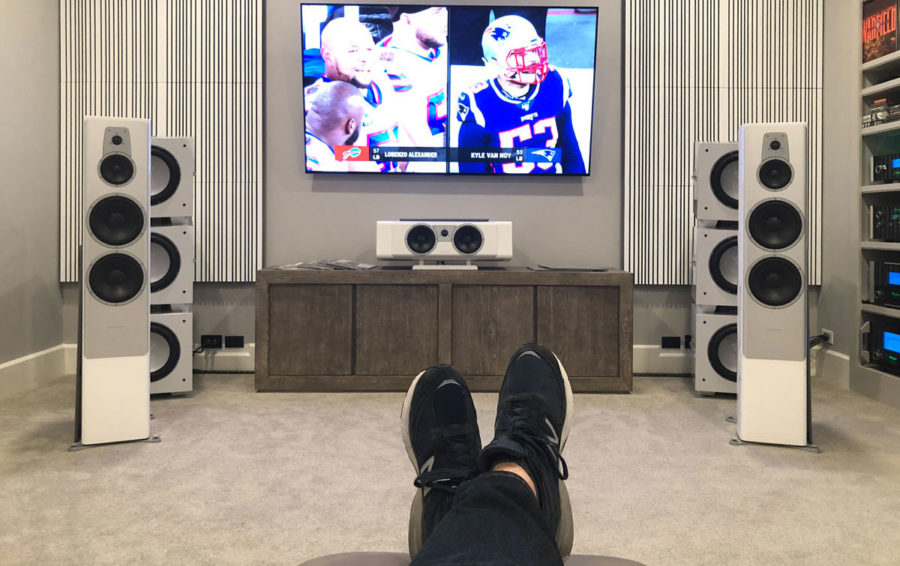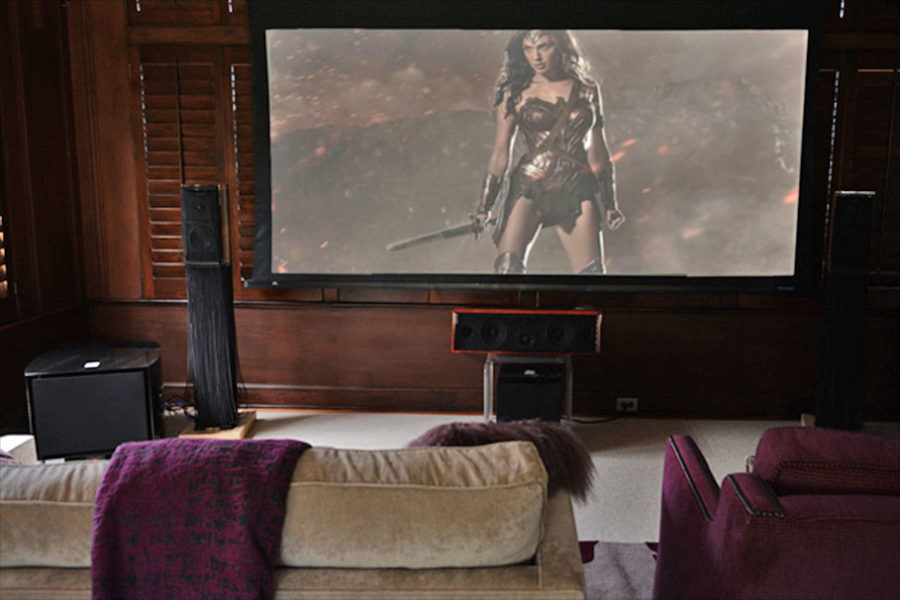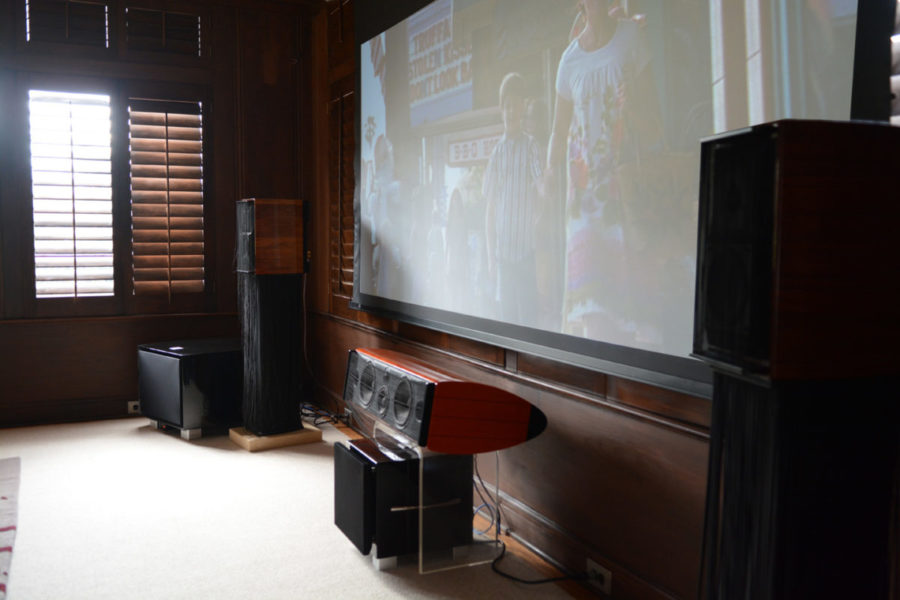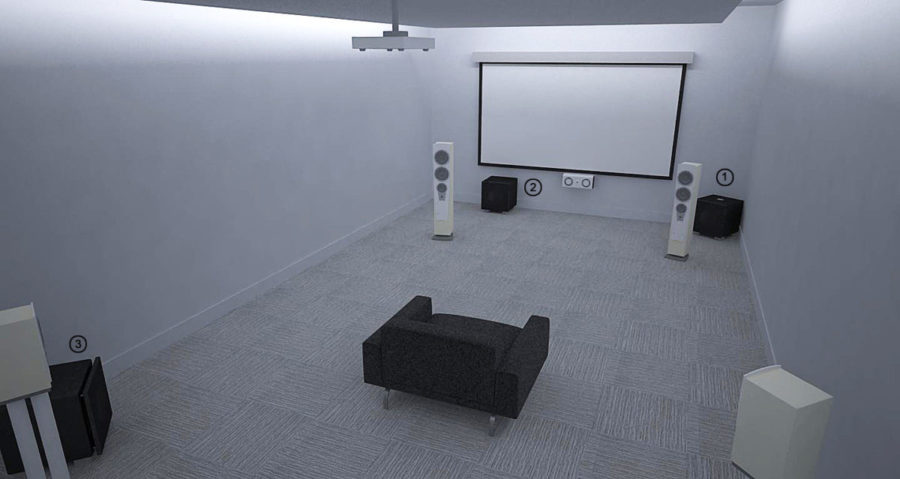Blog
Center Channel RELs Take Center Stage in REL 3-D

In StarTrek: The Next Generation an imaginary device called a Holodek was used to recall a user’s memories. The user was placed in it and transported back to another time, another place where they could relive an experience from earlier in their life. That’s what REL 3D delivers. With one major exception; in REL’s version of the experience one is liberated from the strictures of their own memories, free to wander among the greatest movies of all time. And it starts with Full Range Sound from all channels. Today we’re discussing the center channel speaker with a REL subwoofer (must be a unit with High Level Input) in the context of a REL 3D or HT3D setup. Why? Because about 85% of all sound in the front of the stage is being produced by this one small speaker and once you place a REL underneath the main L-R speakers, the going gets very tough for the center channel speaker.
REL3D and HT3D* are groundbreaking techniques that place the movie viewer within a fully immersive 3-dimensional aural equivalent to Gene Rodenberry’s imaginary Holodek. But we’re getting ahead of ourselves. Dolby Labs could easily lay claim to being the greatest audio company of all time, certainly as it relates to the home theatre experience no one else should even be allowed to apply for the award. Their goal is simple; bringing a translated (that is, after all, what mastering studios accomplish—translation of the commercial movie soundtrack and technology to BluRay or DVD) versions of movie sound into your home and allow a performance that can be superior to commercial theatre to take place in the comfort of one’s own home. But home theatre is only capable of delivering superior performance if a few core tenets are followed scrupulously.

Chief among these is the understanding among professionals that all channels within a theatre need to be Full Range. While Dolby’s original stipulation was a remarkable 20 Hz flat response at an enormously high output level, so much of that range can be delivered at around 25 Hz that for the purposes of all but a professional transfer studio, we believe that figure is sufficient to deliver the full range response Dolby envisioned. And it does so at a price that is thousands of dollars less than if we insist on 20 Hz and demand speed and agility.
Note: When we state 25 Hz is sufficient, we are referring to real, in room performance not numbers achieved in an anechoic chamber
Let me say this again. Your center channel, your left rear surround speaker, heck ALL channels require Full Range sound in order to produce the immersion effects that Ray Dolby, Loan Allen and their merry band of ass kicking engineers envisioned. Sound that swirls around you like Harry Potter’s cloak, that isn’t simply annoying squawks from a severely bandwidth-limited rear channel speaker is what they created. You are placed in the center of the action.
Then mid-fi electronics companies decided to set all AV receivers to 80 Hz at the factory and create no decent starting offsets for levels and delays that would encourage a reasonable starting point. The result is that in virtually 100 percent of audio dealer’s showrooms and many customer’s theatres, the experience is a mere shadow of what it could be. That’s why we try to help, why we write these educational blogs. Because 80 Hz is an awful starting point and unnecessary for virtually any decent 6.5” (170mm) 2-way speaker.
Center channel speakers have possibly the hardest job in your theatre. First of all, just look at the obvious; the poor thing is typically 1/3 the size of each main L-R speaker, yet is asked to deliver 20 times the output. Don’t believe me? Try turning off the center channel while the movie is playing. Boom, almost no sound from the front half of the theatre. The L-R mains provide the all-important context setting, the backdrop that produces correct scale for each scene. But all the heavy lifting is done by the center channel. So, it only makes sense that as soon as you’ve gotten your L-R main speakers paired with the correct REL(s) you expand to the center channel.

If you’re really worried about damaging your speakers, try setting it to 40 Hz. At REL we set all speakers in our theatres to Full Range (and the difference even between 40 Hz and Full Range is massive so do try to sort out how to achieve truly Full Range output). We like to trust the average REL customer is a lot smarter, better at separating fluff through reason and can approach theatre setup as grownups, turning down the volume if it gets too loud.
REL Tip
Be open to purchasing much better center and surround speakers than most customers do. These channels are critical to movie enjoyment.
The REL paired with the center channel speaker should only be connected via our High Level Input, present on all RELs but for our HT range (which is designed to open up performance specifically for the LFE channels in your theatre). When the center channel speaker is set to Full Range in your AV receiver or processor, it will receive information well below 20 Hz which, when partnered with a REL will deliver the huge scale and awesome dynamics that your L-R main channels enjoy (which are already benefitting from 1-2 RELs).
Without the center channel REL, sound becomes squawky, shouty and thin. The huge front sonic stage collapses in the center and can be truly distracting when sound passes from right-to-left or the reverse. In short, the front mains that set the size of the stage are being let down by a center channel that was already stretched to its limits. Now, its straining to the bursting point because it’s attempting to keep up with one (or a pair) of RELs mating to the mains.

OK, so any tips for pulling this together? Of course, great installations are all about technique.
- Remember, set your AVR or Processor to Large (Full Range if possible).
- Then start by setting delay to 3-4 ms (on your AVR menu they call it feet or meters–– 1/3–1/2 meters).
- Play with level and try to balance clarity but avoid the hard, staccato dry sound that is too short a delay setting. You’ll quickly find you’re bouncing back and forth between a click up on volume versus a click of additional delay.
- It’s also critical to rake the center channel speaker backward so that it points upward to the primary listening/viewing seats and your ears. Without this step, dialogue will always lack clarity.
REL Tip
We recommend connecting the High Level cable directly to the rear of the center channel speaker’s binding posts. For a truly neat appearance, once you’re sure the REL and center channel are going to remain exactly where they will be for the next 10 years, feel free to cut the REL High Level cable to length. Leave just a little extra, you never want to cut cables to exactly what you think you’ll need—there’s always a little something needed to dress the cable so it lies flat and doesn’t put strain on your speaker connections.

In the end, a theatre is as capable of being transportive as its center channel. When I say center channel, we always mean truly Full Range in the Dolby-idiom, meaning extended deep bass to around 25 Hz or lower. This truly Full Range center channel sound delivers relaxed, full, richly natural vowelling. Dialogue takes on an easy presence that makes movies an involving experience rather than an annoying, harsh acoustic that is fatiguing and leaves one drained after perhaps 30 minutes. And with a center channel REL properly dialed-in, you’ll finally hear the huge full screen soundstage the director and his sound engineers all enjoyed while making the movie. You’ll be inside your own Holodek.
*REL 3D™ and REL HT3D™ are trademarks of REL Acoustics Ltd and reflect system construction techniques and REL branded products necessary to deliver one of the fundamental principles of Dolby Digital Theatre. Specifically, the goal is to reproduce Full Range signal reproduction from each channel (excepting ATMOS channels) of a Dolby Digital Home Theatre using REL High Level Connectivity, while still delivering the .1/LFE signal simultaneously using a combination of REL subwoofers. Dolby Labs is referenced only insofar as all home theatre relies upon their technologies. No connection between REL Acoustics and Dolby Labs is implied, we make no attempt to claim such linkage, their name is invoked solely to provide attribution in the interest of education.
Watch our video walkthrough of how to connect a subwoofer to your center channel










